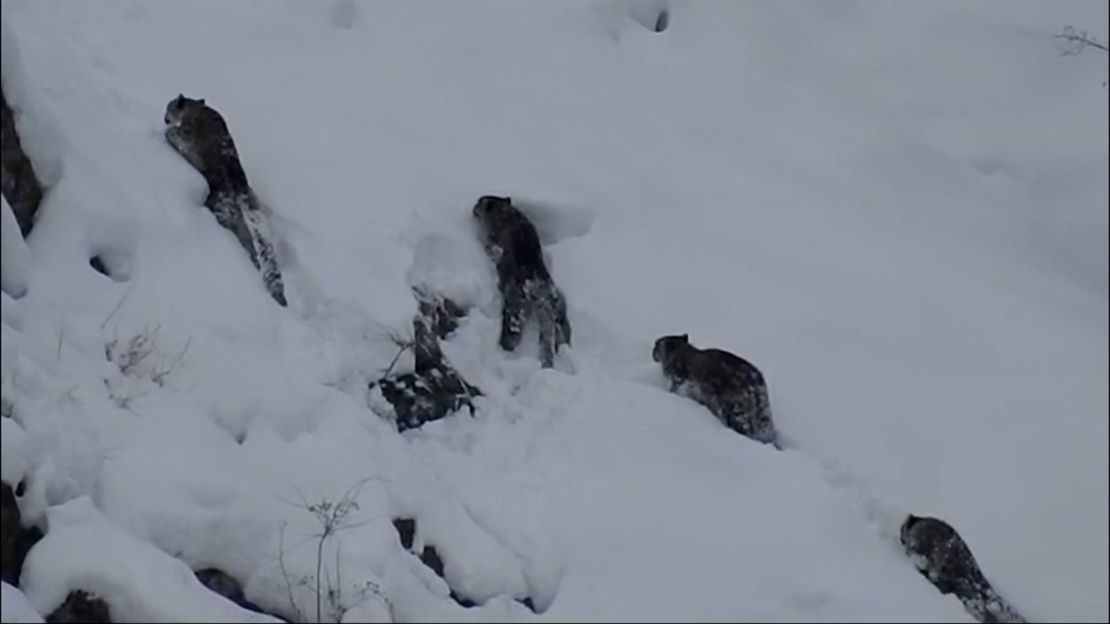Islamabad, Pakistan
CNN
—
Footage of four, rarely-seen snow leopards clambering up snowy cliffs in northern Pakistan has created a frenzy of excitement among conservationists.
Snow leopards are among the world’s most elusive creatures in the wild and it is hard to catch even one on camera, let alone four, with the sighting being celebrated as a success story for Pakistan’s conservation efforts.
Sakhawat Ali, a gamekeeper and photography enthusiast from the remote village of Hushe, captured the footage on March 13 after what he described as “two weeks of tracking their pawprints” through the snow-covered Central Karakoram National Park – close to K2, the world’s second highest mountain.
Ali told CNN the four snow leopards were a mother and her three cubs.
“In the village we are used to seeing snow leopards but, nobody, not even the elders that I spoke to, have ever seen four snow leopards in one go,” he said.

He spotted the mother first, then started noting additional pawprints. He later “got lucky” sighting the animals together while observing a nearby cliff, through binoculars, from the rooftop of his house. He them scampered out with his camera to film them, from a distance of 200 meters.
Ali said neighbors from his village are celebrating the sighting – even though they have some concerns that their livestock could be in danger.
Snow leopards are currently listed as “vulnerable” on the International Union for Conservation of Nature’s (IUCN) Red List of Threatened Species. Known locally as the “ghost of the mountains,” they camouflage easily in their natural habitat of the Karakoram Mountain range in Pakistan’s Gilgit Baltistan region.
Environmental anthropologist Shafqat Hussain says the rocky terrain in the north of Pakistan is perhaps the “best snow leopard habitat in the world.”
They only inhabit high alpine areas of the Himalayas and while their habitat spreads over 12 nations, including China, Bhutan, Nepal, India, Pakistan, Russia, and Mongolia, sightings are exceedingly rare.
Dr Zakir Hussain, Chief Conservator Parks and Wildlife for Gilgit-Baltistan told CNN that the sighting was a “win” for the work being done to increase awareness amongst local communities about the importance of protecting snow leopards. He said eighty percent of community members are now involved in conservation, tracking and awareness activities.
The World Wildlife Fund for Nature, Pakistan, said it was optimistic about the sighting but stressed snow leopards remain an endangered species still facing “numerous threats.”
In a statement, it said it’s crucial that local communities “work together to protect and conserve these incredible big cats, ensuring future generations can witness their splendor in the wild.”
According to the United Nation’s Environment Program “human activities and growing livestock herds in some areas have led to the degradation of pastureland and wildlife habitats,” affecting the snow leopards food supplies.
Other threats according to the UNEP include poaching and the fragmentation of the animal’s habitat due to massive new infrastructure projects in addition to climate change – which is “expected to aggravate these existing threats.”
In 2023, Pakistan was ranked as the 5th most vulnerable country to climate change according to the World Bank’s Global Climate Risk Index.

